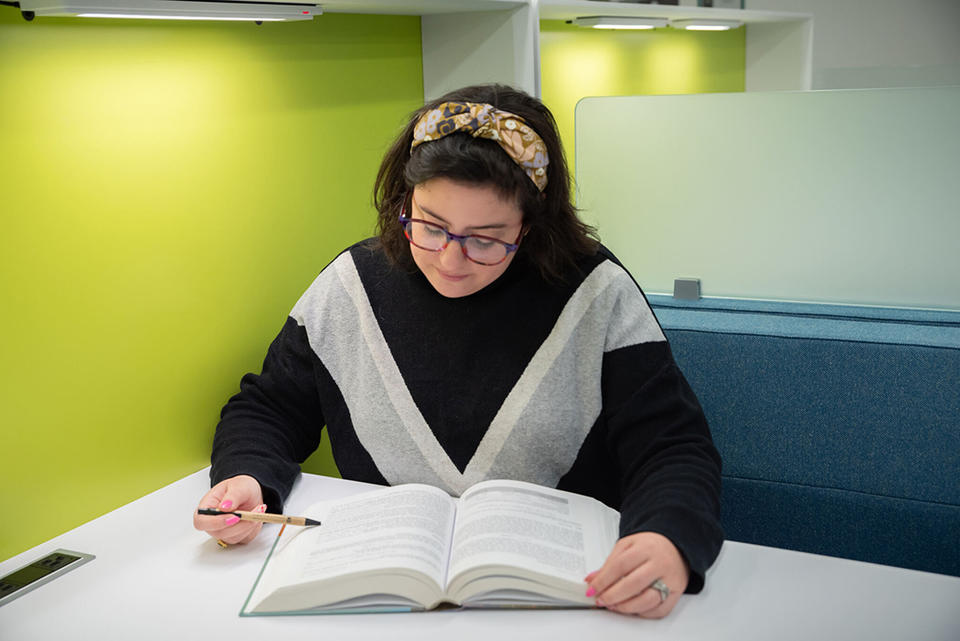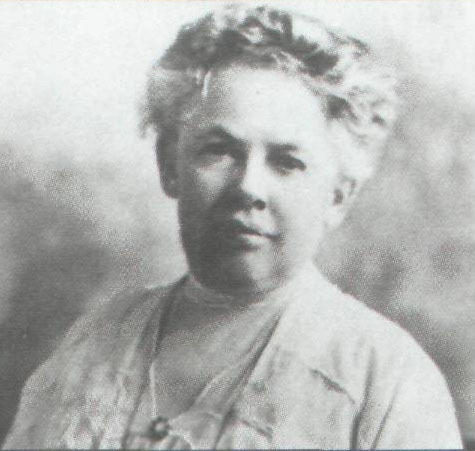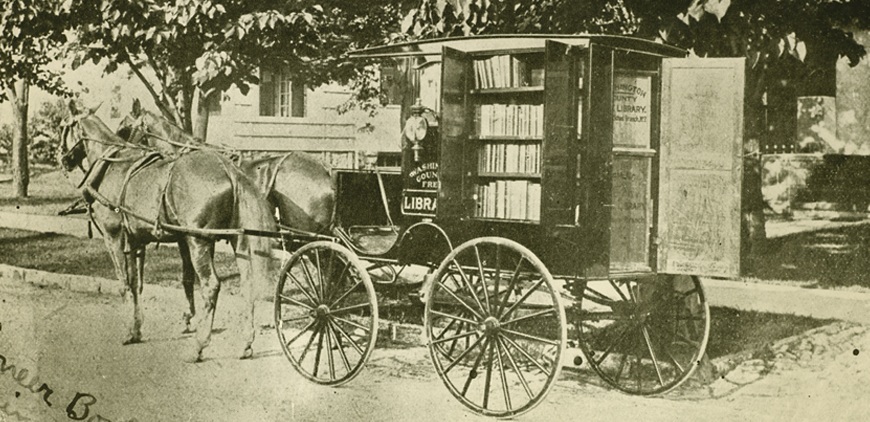Taking Measure
Just a Standard Blog
From Bookmobiles to Big Data, How Library Scientists Make Information Accessible to All

Though she was a librarian more than 100 years ago, Mary Lemist Titcomb inspired NIST librarian Kathryn Miller’s career. Both women have a passion for getting books and knowledge out to the public.
The thrill of finding a new book — what could be better? As a kid, nothing was more exciting than walking into a library and discovering my next adventure.
Well, that was until I discovered that libraries could bring books to me. In a van! To my neighborhood! Now, that was exciting.
Fast forward a few decades, and I found myself in graduate school studying library science.
In a lesson about providing access and outreach to communities, we learned about the librarian who came up with the idea of bringing books to the public via horse and buggy — Mary Lemist Titcomb. In 1905, it was called a book wagon.
Today, they’re more commonly known as bookmobiles. I was brought back to the first time I saw a van full of books at a neighborhood event, with librarians waiting to help me learn and discover. It all made sense now. This is why I’m studying library science!
Titcomb very much inspired me in my career journey as a librarian. She reminded me that library science is more than arranging and cataloging books and documents in dusty basements (though there is a lot of that!). It’s applying that science to the communities you want to serve.
This epiphany eventually led me to NIST. As a librarian at NIST, my main role is to help our researchers get their work out to the public in the most accessible way possible. Unlike Titcomb’s, my job does not involve a horse and buggy (I’ll stick to my book carts and Subaru, thank you!). But we both share a passion for getting information and knowledge to people who need it.
I love the idea of bringing information to people where they are, and that has been the thread throughout my career so far and how I approach being a librarian.
Bringing Books to the People

Mary Lemist Titcomb decided she wanted to be a librarian at a time when no formal training schools existed, and the profession could only be learned through unpaid apprenticeships. The field was also very male-dominated at the time, though most librarians today are women.
Titcomb was eventually hired as a cataloger and worked her way up to chief librarian of the Rutland Public Library in Vermont. During her first decade as a professional librarian, she applied to be a librarian at the 1893 Chicago World’s Fair.
She received a rejection letter from Melvil Dewey, the president of the American Library Association, which stated that he only wanted “women who have been very prominent in the national association and its work and who are very familiar with general library interests throughout the country … however admirable Miss Titcomb’s work may have been with you [the Vermont library], she has not made herself known outside.”
You might recognize Dewey’s name if you’ve ever had to find a book at a library. He’s the namesake of the numerical classification of library books, known as the Dewey Decimal Classification. You may also recognize that the expectation for women to be “rock stars” in a profession dominated by men hasn’t changed much since the late 19th century.
Titcomb wanted to rise to Dewey’s challenge. She found a chance in 1902 when she was hired at a tiny county library in Hagerstown, Maryland — my home state and not far from our campus in Gaithersburg, Maryland. Titcomb’s immediate focus was on making the library more useful to the community. At the time, Washington County had a mostly agricultural population spread out over a large area (50,000 people over 500 square miles). This is how the bookmobile was born, because as Titcomb writes:
“The book goes to the man. We do not wait for the man to come to the book. Our British critics would call this a concrete example of the frantic rushing about of the American librarian, but we all know that we might wait long before a busy farmer would ride five, ten, or fifteen miles for a coveted volume.”
While I want to update her use of “man” to “people,” this sentiment of bringing information to the people is exactly how I approach my own work as a librarian. It’s a no-brainer for both me and Mary.
Titcomb worked out a schedule, planned the routes and designed the wagon. Titcomb asked the library’s janitor, Joshua Thomas, who was familiar with the area and the community, to be the driver and lead horses Black Beauty and Dandy twice a week. In April 1905, the wagon set out and made stops at every residence along the route to introduce the “experiment” and meet the families.

In the first six months, the wagon lent over 1,000 books to the residents of Washington County. It continued delivering books for five years until the wagon and its books were destroyed while crossing train tracks. (Luckily, Thomas and the horses were fine.)
The program was so successful that the library’s board of trustees funded a new wagon.
But this wagon had a different kind of horsepower — a motor. Now, with a bookmobile, they could reach everyone in the community and carry a wider variety of books. Other libraries within the United States started their own bookmobile programs, with many (including the Washington County Free Library) still running today.
All of this work Titcomb had done in her small library started to catch people’s attention outside the immediate community. Even Dewey himself sent her a postcard saying: “I congratulate you on the splendid work you are doing and congratulate Maryland much more in having secured you for it.”
I guess Titcomb had proved herself to Dewey, as she was elected to serve as the second vice president of the American Library Association in 1914. She started one of the first official librarian training programs in 1924.
Her experience creating the first book wagon was used in writing the 1929 American Library Association specifications for book automobiles. The specifications included everything a library would need to start its own bookmobile program — down to the paint and lettering. We love a standard here at NIST, especially one that involves getting books out to people!
The science of bringing information to people has changed a lot since Mary Titcomb delivered books to everyone around Hagerstown, Maryland, by horse and buggy. But the commitment to making information accessible to all remains the same, and Mary’s story helped inspire me to make library science my career.
Winding Road to Library Science
My path to library science was probably as complicated and winding as one of the routes Titcomb planned for her first book wagon.
I found myself at a loss as to what to do after getting my undergraduate degree in English and theater. So, I joined AmeriCorps and was placed in Maine at a children’s museum and theater. One of my projects during my term was digitizing and organizing old photos for this theater that had been around since the 1920s.
All of these wonderful artifacts had been locked in a plastic tub for decades. Now, I was able to put them online and research and organize them, so they’d be easier to find. I remember wondering if I could do this professionally. I did some research and found a master’s degree program in library and archival science back in my hometown.
I took another winding path trying to decide what type of librarian I wanted to be, which led me to an internship at NIST. My favorite part about my work at NIST was that everything was in the public domain. I didn’t have to worry about copyright or licenses. The main goal was to get the information out to the public in a usable format.
I was excited to get a full-time librarian position here as the publishing services librarian. Now, I focus on helping our researchers publish their work and make it accessible to the public. Notice a pattern here?
We produce so many publications at NIST that show the results of our research, such as cybersecurity best practices or guides to help communities prepare for disaster. The research won’t benefit people if we don’t make it available, accessible and discoverable. If research lives on a static webpage and no one looks at it, it won’t help anybody.
That’s why, at the NIST Research Library and Museum, our goal is to make sure NIST researchers’ work is accessible to the public and in the appropriate publications where people can find it — especially other researchers who may build on our work.
It’s also important to us as a government library because all of our research is publicly funded, and we make it all available to the public after a certain embargo.
So many great library scientists at NIST work in varied areas such as archival science, data science and more. All this work is done to enhance and support NIST’s overall work in measurement science, standards and technology.
Most people don’t think of librarians as scientists. But library science is, in fact, a science! It has also come a long way since Dewey and other men made decisions about the profession. Not only has library science moved from just classifying books to classifying all information resources, but women are more likely to be seen in leadership positions. Carla D. Hayden, the current librarian of Congress, is a perfect example of a librarian who has helped the profession grow and made such an impact on how library science is viewed in the 21st century.
The applied science of information — curation, organization, access, preservation and regulation — is all a science that supports the research we do here at NIST.
Information Accessibility Is Complex, But It’s the Goal
Like Mary Titcomb, I’m always thinking about how to make information more accessible.
For NIST publications, that means moving beyond PDF documents to accessible, web-based formats. PDF documents can be challenging to make accessible for people with disabilities. We’ve moved our data into web-based formats for our publications to continue to make all of our work more usable for everyone.
I’ve already worked on guidance for using inclusive language in our publications. But to be totally inclusive, our publications need to be digitally accessible — as accessible as our data. Not only will this benefit users who rely on assistive technologies for electronic information, but it will also allow our researchers to write, access and reuse publications more systematically.
I’ll continue working toward making NIST’s research more open and accessible — with Mary Titcomb as my inspiration — during Women’s History Month and all year long.
Book cited: Glenn, Sharlee Mullins (2018). Library on Wheels: Mary Lemist Titcomb and America's First Bookmobile. New York: Abrams Books for Young Readers. ISBN 9781683352921. OCLC 1030992512.





